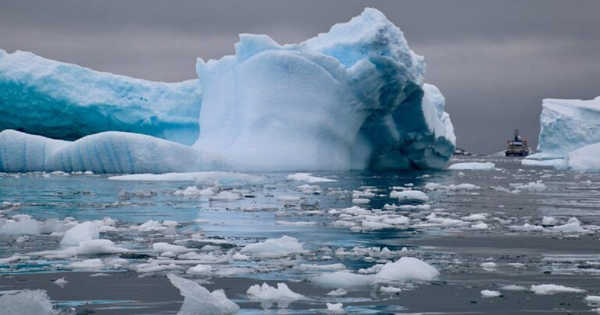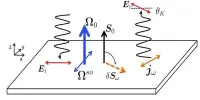The sun is a frightening source of electromagnetic chaos—chaotic, random energy emitted by the massive ball of gas reaches Earth in a wide range of radio frequencies. However, in the midst of the randomness, Stanford researchers discovered the seeds of a powerful tool for monitoring ice and polar changes on Earth and throughout the solar system.
In a new study, a team of glaciologists and electrical engineers demonstrate how radio signals naturally emitted by the sun can be converted into a passive radar system for measuring the depth of ice sheets, which they successfully tested on a Greenland glacier. According to the researchers, the technique, described in the journal Geophysical Research Letters, could lead to a cheaper, lower-power, and more widespread alternative to current data collection methods. The breakthrough could provide large-scale, long-term insight into melting ice sheets and glaciers, which are among the primary causes of sea-level rise threatening coastal communities worldwide.
A sky full of signals
Airborne ice-penetrating radar—the primary current method for gathering extensive information about the polar subsurface—involves flying planes equipped with a high-powered system that sends its own ‘active’ radar signal down through the ice sheet. However, the project is time-consuming and only provides information about the conditions at the time of the flight.
A team of glaciologists and electrical engineers show how radio signals naturally emitted by the sun can be turned into a passive radar system for measuring the depth of ice sheets and successfully tested it on a glacier in Greenland.
The researchers’ proof of concept, on the other hand, employs a battery-powered receiver with an antenna placed on the ice to detect the sun’s radio waves as they travel down to Earth, through the ice sheet, and to the subsurface. In other words, rather than transmitting its own signal, the system makes use of naturally occurring radio waves that are already on their way down from the sun, a nuclear-powered transmitter in the sky. According to the researchers, if this type of system were fully miniaturized and deployed in large sensor networks, it would provide an unprecedented look at the subsurface evolution of Earth’s rapidly changing polar conditions.
“Our goal is to chart a course for the development of low-resource sensor networks that can monitor subsurface conditions on a very large scale,” said lead study author Sean Peters, who worked on the study as a graduate student at Stanford and now works at the MIT Lincoln Laboratory. “That could be difficult with active sensors, but this passive technique allows us to take full advantage of low-resource implementations.”

A random advantage
The sun constantly emits radio waves across a wide, random spectrum of frequencies, in addition to visible and other types of light. The researchers took advantage of the chaos: They recorded a snippet of the sun’s radioactivity, which is like an endless song that never ends, and then looked for that distinct signature in the echo created when solar radio waves bounce off the bottom of an ice sheet. They can calculate the distance between the surface receiver and the ice sheet’s floor, and thus its thickness, by measuring the delay between the original recording and the echo.
The researchers calculated an echo delay time of about 11 microseconds in their test on Store Glacier in West Greenland, which maps to an ice thickness of about 3,000 feet—a figure that matches measurements of the same site recorded by both ground-based and airborne radar.
“It’s one thing to do a bunch of math and physics and convince yourself that something should be possible—quite it’s another to see an actual echo from the bottom of an ice sheet using the sun,” senior author Dustin Schroeder, an assistant professor of geophysics at Stanford’s School of Earth, Energy, and Environmental Sciences, said (Stanford Earth).
From Jupiter to the sun
The idea of using passive radio waves to collect geophysical measurements of ice thickness was first proposed by study co-author and NASA’s Jet Propulsion Laboratory researcher Andrew Romero-Wolf as a way to investigate Jupiter’s icy moons. As Schroeder and Romero-Wolf worked on a mission with others, it became clear that radio waves generated by Jupiter would interfere with their active ice-penetrating radar systems. At one point, Romero-Wolf realized that, rather than being a weakness, Jupiter’s erratic radio emissions could be turned into a source for probing the moons’ subsurfaces.
“We started talking about it in terms of Jupiter’s moon Europa, but then we realized it should work for observing Earth’s ice sheets as well if we replaced Jupiter with the sun,” Schroeder explained.
Following that, the research team set about isolating the sun’s ambient radio emissions to see if they could be used to measure ice thickness. The method entailed raising a subset of the sun’s 200- to 400-megahertz radio frequency band above the noise of other celestial bodies, processing massive amounts of data, and removing man-made electromagnetism sources such as TV stations, FM radio, and electronic equipment.
While the system only works when the sun is above the horizon, the proof-of-concept allows for future adaptation to other naturally occurring and man-made radio sources. The co-authors are also still working on their original idea of applying this technique to space missions by harnessing the ambient energy emitted by other astronomical sources such as Jupiter’s gas giant.
“Pushing the boundaries of sensing technology for planetary research has enabled us to push the boundaries of sensing technology for climate change,” Schroeder explained. “Monitoring ice sheets in the face of climate change and exploring icy moons on the outer planets are both extremely low-resource environments in which you really need to design elegant sensors that don’t require a lot of power.”
















